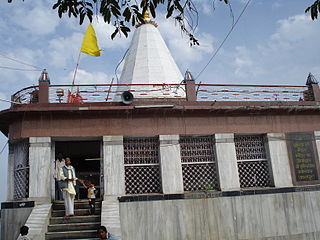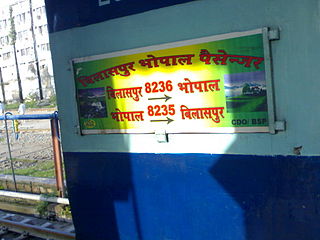
The Satpura Range is a range of hills in central India. The range rises in eastern Gujarat running east through the border of Maharashtra and Madhya Pradesh and ends in Chhattisgarh. The range parallels the Vindhya Range to the north, and these two east–west ranges divide Indian Subcontinent into the Indo-Gangetic plain of northern India and the Deccan Plateau of the south. The Narmada River originates from north-eastern end of Satpura in Amarkantak, and runs in the depression between the Satpura and Vindhya ranges, draining the northern slope of the Satpura range, running west towards the Arabian Sea. The Tapti River originates in the eastern-central part of Satpura, crossing the range in the center and running west at the range's southern slopes before meeting the Arabian Sea at Surat, draining the central and southern slopes of the range. Multai, the place of Tapi river origin is located about 465 kilometer far, south-westerly to Amarkantak, separated across by the hill range. The Godavari River and its tributaries drain the Deccan plateau, which lies south of the range, and the Mahanadi River drains the easternmost portion of the range. The Godavari and Mahanadi rivers flow into the Bay of Bengal. At its eastern end, the Satpura range meets the hills of the Chotanagpur Plateau. The Satpura Range is a horst mountain and is flanked by Narmada Graben in the north and much smaller but parallel Tapi Graben in the south.

Rewa is a city in the north-eastern part of Madhya Pradesh state in India. It is the administrative center of Rewa District and Rewa Division. The city lies about 420 kilometres (261 mi) northeast of the state capital Bhopal and 230 kilometres (143 mi) north of the city of Jabalpur. The maximum length of Rewa district is 125 km from east to west and the length of Rewa from north to south is 96 km. This area is surrounded by Kaimur hills to the south Vindhyachal ranges pass through the middle of the district.

Rewa district is a district of the Madhya Pradesh state in central India. The city of Rewa is the district headquarter. Rewa is sometimes called – 'Land of White Tigers' as the first White Tiger was discovered here in 1951 by Maharaja of the province, Martand Singh in the nearby jungle of Govindgarh. Rewa was the capital city of once a state – Vindhya Pradesh.

Shahdol District is a district of Madhya Pradesh state in east central India. It old name was Matsya raj or Virat kingdom in the name of great king Maharaja Virata. With a total area of 6,205 km2 (2,396 sq mi) and a population of 10,66,063. Shahdol is an important district of Madhya Pradesh. The town of Shahdol is the district headquarters. The district formerly comprised Shahdol division.
Satna is a city in the Indian state of Madhya Pradesh. It serves as the headquarters of Satna district. It is 7th largest city and 8th most populous city of the state. The city is 500 km east of the state capital Bhopal. The city is distributed over a land area of 111.9 square kilometres.
Bijuri is a town and a Municipality or Municipal Council or Nagar Palika Parishad in Anuppur district in the state of Madhya Pradesh, India.
Burhar is a town and nagar panchayat in Shahdol district in the state of Madhya Pradesh, India. Burhar was named after Budhi Mata, a local deity. It also has a temple belonging to her, in Purani Basti. Burhar is one of the fastest emerging commercial hubs of the division due to its geographical location.
Nowrozabad or Khodargama is a city and a Nagar Palika in Umaria district in the Indian state of Madhya Pradesh. Kendriya Vidyalaya Nowrozabad is situated in the G.M Complex Johilla area. Nowrozabad is the head office of Johilla area. The nearest Airport is at Jabalpur in Madhya pradesh. Nowrozabad Railway Station is on the Katni - Anuppur rail route. There are many coal mines around here. National Highway 43 has its route through Nowrozabad.

Satna District is a district of Madhya Pradesh state in central India. The city of Satna is the district headquarters. The district has an area of 7,502 km², and a population of 22,28,935(2011 census), 20.63% of which is urban. The district has a population density of 249 persons per km².

Govindgarh, the summer capital of Mahraja Rewa, is about 18 km from Rewa in Madhya Pradesh, India. The is Rewa, with an area of about 13,000 mi², was the largest princely state in the Bagelkhand Agency and the second largest in Central India Agency. The British political agent for Bagelkhand resided at Satna, on the East Indian railway. The Bagelkhand capital establish in Rewa under the Rewa Maharaja.Bagheli is the local language of the region.It's neighbouring towns are Manikawar, Gurh and Rewa.
Dindori, formerly known as Ramgarh, is a district head office and a nagar panchayat in Dindori district in the state of Madhya Pradesh, India. Dindori has many historical as well as spiritual places. Some of the spiritual places are Laxman Madva, Kukarramath, Kalchuri Kali Mandir etc. Kanha Tiger Reserve is 180 km & Bandhavgarh National Park is 140 Km away from the district headquarter.
Bahoriband is a Tehsil and a Gram panchayat in Katni district in the Indian state of Madhya Pradesh. Bahoriband Tehsil Headquarters is Bahoriband town. It belongs to Jabalpur Division. It is located 44 km towards west from District headquarters Katni. 320 km from State capital Bhopal towards west. Bahoriband Tehsil is bounded by Sihora Tehsil towards South, Majhouli Tehsil towards South, Rithi Tehsil towards North, Murwara Tehsil towards East. Jabalpur City, Umaria City, Katni City are the nearby cities to Bahoriband.
The Surguja Express is a daily express train of North Central Railway, in India, running between Gwalior City in Madhya Pradesh and Ambikapur town in Chhattisgarh.
Damoy village is located to the North East of Umaria district of Madhya Pradesh. The nearby villages are Indwar, Bharewa, Mugwani, Ashodh, Chandwar, Chinsura, Baturawah, Surtan, Bholgarh etc.

The Bhopal–Bilaspur Express/Passenger, is an express passenger train service running between Bhopal Junction railway station of Bhopal City, the capital city of Madhya Pradesh and Bilaspur in Chhattisgarh
Umaria Coalfield is located in Umaria district in the Indian state of Madhya Pradesh in the valley of the Umrer River, a tributary of the Son River.
Beohari is a major town and a nagar panchayat in Shahdol district in the state of Madhya Pradesh, India. It is 79.07 kilometres (49.13 mi) from the main district of Shahdol and 412 kilometres (256 mi) away from Bhopal, the state capital. Its geographical coordinates are 24° 3' 0" North, 81° 23' 0" East.
Nipaniya is a village in Beohari Tehsil in Shahdol District of Madhya Pradesh State, India. It belongs to Shahdol Division. It is located 95 km north of the district headquarters of Shahdol, 31 km from Beohari Tehsil and 454 km from the State capital, Bhopal.
Birsinghpur railway station is a railway station on Bilaspur–Katni line under Bilaspur railway division of South East Central Railway Zone of Indian Railways. The railway station is situated beside National Highway 43 at Pali Birsinghpur in Umaria district in the Indian state of Madhya Pradesh.
Sohagpur is a Town and Tehsil in Shahdol District of Madhya Pradesh. It is one of 4 Tehsils of Shahdol district. There are 318 villages in Sohagpur Tehsil. Rewa State Gazetteer refers to a tradition which connects Sohagpur with King Virata of the epic Mahabharata.










